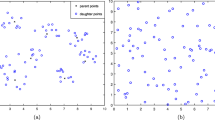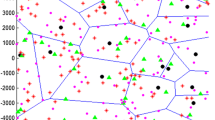Abstract
The cellular networks in 5G are tending to be heterogeneous and ultra-dense networks. The methods used in traditional hexagonal grid model are no more adaptive to the 5G heterogeneous cellular networks today, which are too idealized and inaccurate. A popular approach for analyzing heterogeneous cellular networks is using Poisson point process (PPP), which assumes that the deployment of base stations (BSs) is completely space random (CSR) and from which we can get a lower bound of the probability of coverage probability. However, geographical and human factors should be taken into account in reality. The BSs or mobile users may be clustered in crowded areas such as enterprises and shopping malls so that the space distribution based on PPP will be inaccurate. This motivates us to find a new approach to settle it. In this paper, we focus on using Poisson clustered process (PCP) to model ultra-dense 5G heterogeneous cellular networks which include macrocells, picocells and femtocells. First of all, a model of the locations of BSs based on Poisson clustered process (PCP) has been proposed, and the formation of clusters of the BSs has been discussed. Then the probability model of coverage and its three special cases using SINR have been derived, and the proposed model obeys to the cell selection mechanism based on instantaneous SINR. Finally, according to the proposed model, comparison and analysis of coverage probability using hexagonal grid model, PCP and PPP are done respectively. The numerical results show that using PCP can get higher coverage probability than using PPP.




Similar content being viewed by others
References
Cisco. (2015). Cisco visual networking index: Forecast and methodology, 2014–2019 white paper.
Ericsson (2011). More than 50 billion connected devices, ericsson white paper.
You, X. H., Pan, Z. H. W., Gao, X. Q., Cao, S. M., & Wu, H. Q. (2014). The 5G mobile communication: the development trends and its emerging key techniques. Science China Information Sciences, 44(5), 551–563. (In Chinese).
Liu, J., Nishiyama, H., Kato, N., & Guo, J. (2016). On the outage probability of device-to-device-communication-enabled multichannel cellular networks: an rss-threshold-based perspective. IEEE Journal on Selected Areas in Communications, 34(1), 163–175.
Björnson, E., Larsson, E. G., & Debbah, M. (2016). Massive MIMO for maximal spectral efficiency: How many users and pilots should be allocated? IEEE Transaction on Wireless Communications, 15(2), 1293–1308.
Haenggi, M. (2012). Stochastic geometry for wireless networks. Cambridge: Cambridge University Press.
Haenggi, M., Andrews, J. G., Baccelli, F., et al. (2009). Stochastic geometry and random graphs for the analysis and design of wireless networks. IEEE Journal on Selected Areas in Communications, 27(7), 1029–1046.
Cardieri, P. (2010). Modeling interference in wireless ad hoc networks. IEEE Communications Surveys & Tutorials, 12(4), 551–572.
Elsawy, H., Hossain, E., & Haenggi, M. (2013). Stochastic geometry for modeling, analysis, and design of multi-tier and cognitive cellular wireless networks: A survey. IEEE Communications Surveys & Tutorials, 15(3), 996–1019.
Wyner, A. D. (1994). Shannon-theoretic approach to a Gaussian cellular multiple-access channel. IEEE Transactions on Information Theory, 40(6), 1713–1727.
Shamai, S., & Wyner, A. D. (1997). Information-theoretic considerations for symmetric, cellular, multiple-access fading channels—parts I & II. IEEE Transactions on Information Theory, 43(11), 1877–1911.
Somekh, O., & Shamai, S. (2000). Shannon-theoretic approach to a Gaussian cellular multi-access channel with fading. IEEE Transactions on Information Theory, 46(4), 1401–1425.
Mhatre, V. P., & Rosenberg, C. P. (2006). Impact of network load on forward link inter-cell interference in cellular data networks. IEEE Transaction on Wireless Communication, 5(12), 3651–3661.
Charoen, P. & Ohtsuki, T. (2011). Codebook based interference mitigation with base station cooperation in multi-cell cellular network. In Proceeding of IEEE Vehicular Technology Conference (VTC Fall), San Francisco, CA (pp. 1–5).
Nocetti, F. G., Stojmenovic, I., & Zhang, J. Y. (2002). Addressing and routing in hexagonal networks with applications for tracking mobile users and connection rerouting in cellular networks. IEEE Transactions on Parallel and Distributed Systems, 13(9), 963–971.
Guo, P., Wang, J., Li, B., & Lee, S. (2014). A variable threshold-value authentication architecture for wireless mesh networks. Journal of Internet Technology, 15(6), 929–936.
Xie, S., & Wang, Y. (2014). Construction of tree network with limited delivery latency in homogeneous wireless sensor networks. Wireless Personal Communications, 78(1), 231–246.
Andrews, J. G., Baccelli, F., & Ganti, R. K. (2011). A tractable approach to coverage and rate in cellular networks. IEEE Transactions on Communications, 59(11), 3122–3124.
Dhillon, H. S., Ganti, R. K., Baccelli, F., & Andrews, J. G. (2012). Modeling and analysis of K-tier downlink heterogeneous cellular networks. IEEE Journal on Selected Areas in Communications, 30(3), 550–560.
Vu T. T., Decreusefond, L. & Martins, P. (2012). An analytical model for evaluating outage and handover probability of cellular wireless networks. In Proceeding of 2012 International Symposium on Wireless Personal Multimedia Communications (WPMC), Taipei (pp. 643–647).
Busson, A., Chelius, G., & Gorce, J. M. (2009). Interference modeling in CSMA multi-hop wireless networks (pp. 237–242). Rennes, France: HAL-INRIA.
Busson, A. & Chelius, G. (2009). Point processes for interference modeling in CSMA/CA ad hoc networks. In ACM International Workshop on PERFORMANCE Evaluation of Wireless Ad Hoc, Sensor, and Ubiquitous Networks, Pe-Wasun 2009, Tenerife, Canary Islands, Spain, (pp. 33–40).
Haenggi, M. (2011). Mean interference in hard-core wireless networks. IEEE Communications Letters, 15(8), 792–794.
Na, Deng, Zhou, W., & Haenggi, M. (2015). The ginibre point process as a model for wireless networks with repulsion. IEEE Transactions on Wireless Communications, 14(1), 107–121.
Lee, C. H., & Haenggi, M. (2012). Interference and outage in poisson cognitive networks. IEEE Transaction on Wireless Communication, 11(4), 1392–1401.
Ganti, R. K., & Haenggi, M. (2007). Interference and outage in clustered wireless ad hoc networks. IEEE Transactions on Information Theory, 55(9), 4067–4086.
Chun, Y. J. & Hasna, M. O. (2014). Analysis of heterogeneous cellular networks interference with biased cell association using Poisson cluster processes. In International Conference on Information and Communication Technology Convergence, Busan (pp. 319–324).
Chiu, S. N., Stoyan, D., Kendall, W., & Mecke, J. (2013). Stochastic geometry and its applications (3rd ed.). New York: Wiley.
Peng, J., Hong, P., & Xue, K. (2015). Energy-aware cellular deployment strategy under coverage performance constraints. IEEE Transactions on Wireless Communications, 14(1), 69–80.
Haenggi, M., & Ganti, R. K. (2009). Interference in large wireless networks. Foundations and Trends ® in Networking, 3(2), 127–248.
Stoyan, D., Kendall, W. S., & Mecke, J. (1995). Stochastic geometry and its applications (2nd ed.). New York: Wiley.
Acknowledgements
This work is jointly supported by the National Natural Science Foundation of China (No. 61572074), A Project Funded by the Priority Academic Program Development of Jiangsu Higher Education Institutions, Jiangsu Collaborative Innovation Center on Atmospheric Environment and Equipment Technology.
Author information
Authors and Affiliations
Corresponding author
Rights and permissions
About this article
Cite this article
Liu, Ly., Ma, Zg., Xue, Y. et al. Research on Coverage Probability in Ultra-Dense 5G Heterogeneous Cellular Networks Based on Poisson Clustered Process. Wireless Pers Commun 95, 2915–2930 (2017). https://doi.org/10.1007/s11277-017-3970-4
Published:
Issue Date:
DOI: https://doi.org/10.1007/s11277-017-3970-4




